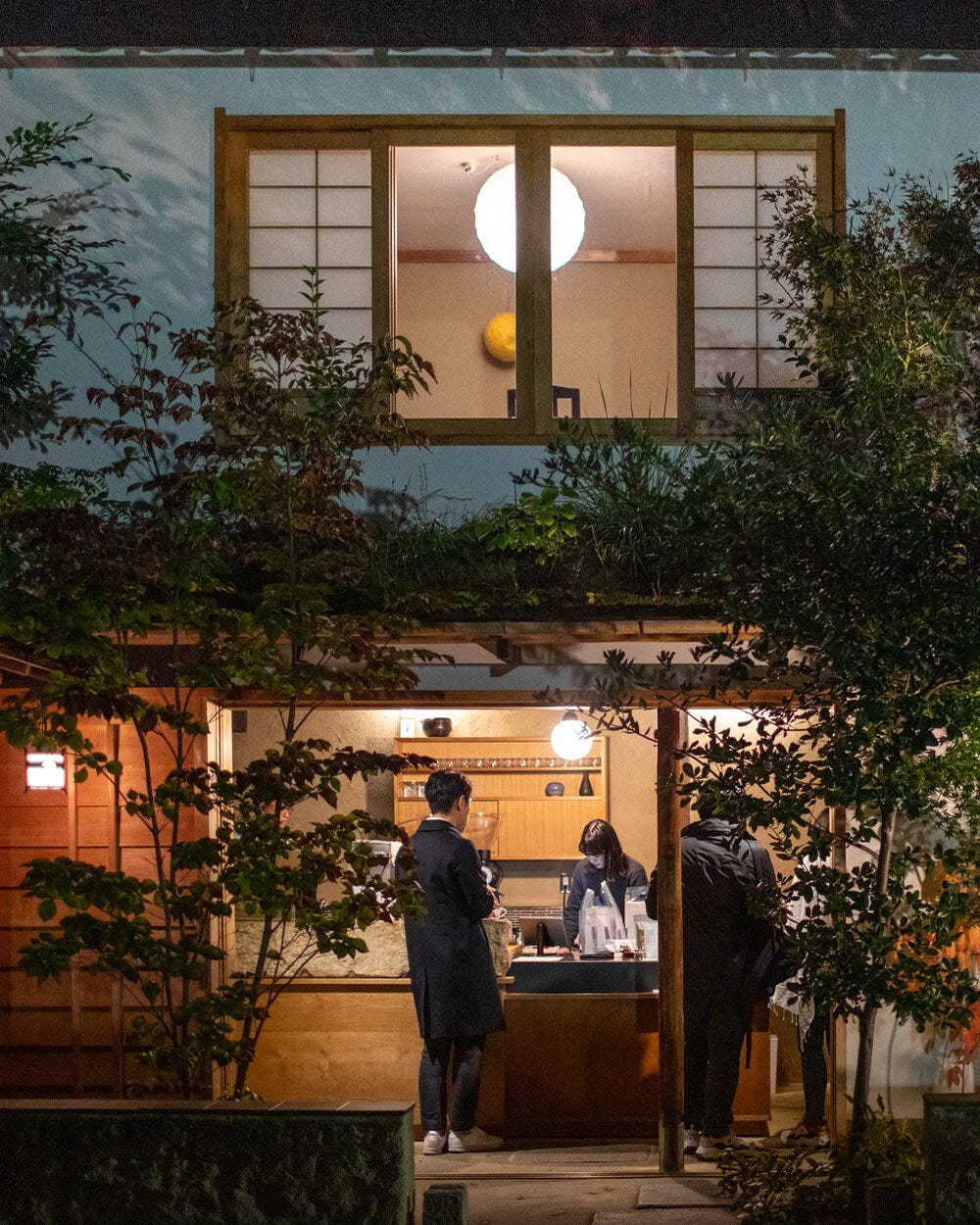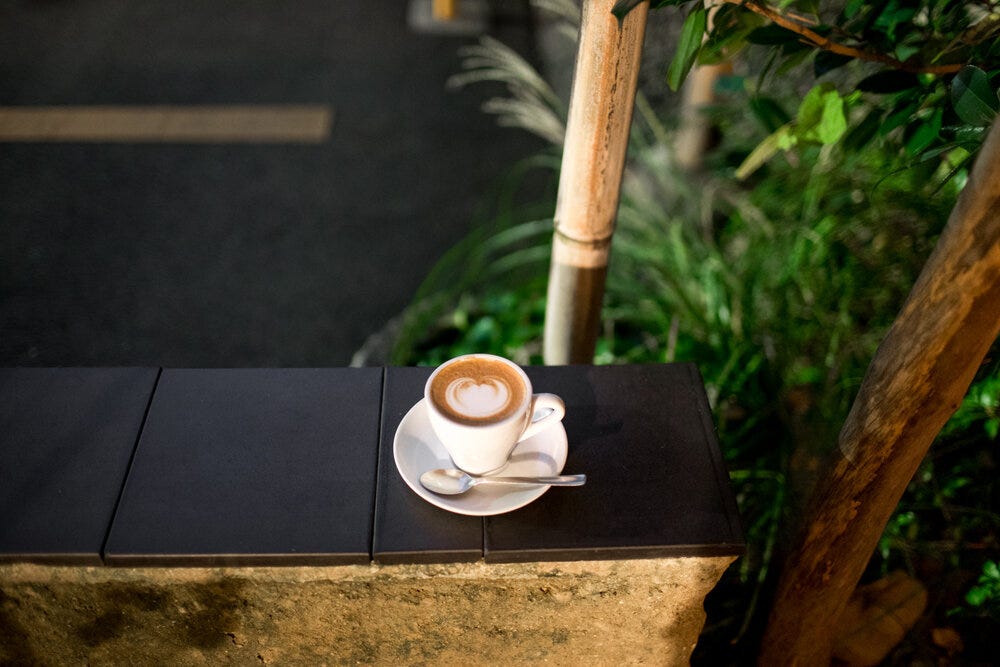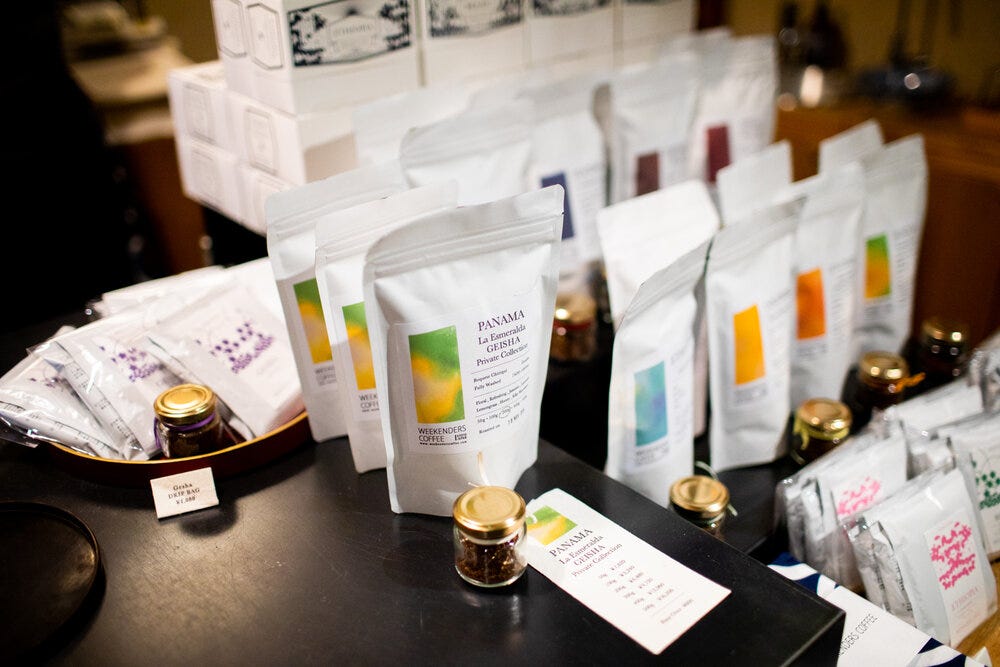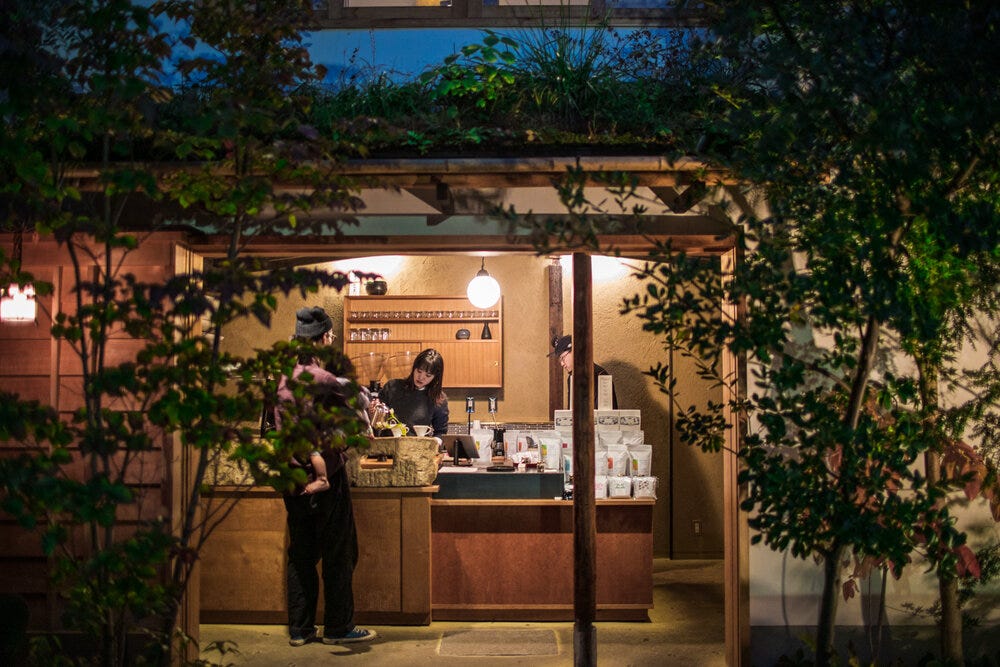Where Tradition Blends with Modernity: WEEKENDERS Coffee in Kyoto, Japan
Editor’s Note: this post is part of a travel series on the Atlanta Coffee Shops blog. The series is tagged #ACStravels so you can find it here on the blog or on social media.
One of the most quintessential specialty coffee shops in Kyoto, Japan sits on the far side of a car parking lot and is difficult to find.
This coffee shop is WEEKENDERS Coffee.
Even armed with exact GPS coordinates of this coffee shop, it is easy to miss. I made several sweeping 360 degree movements before I spotted WEEKENDERS1—it’s located about 30 to 40 meters deep into the parking lot—off a small side street in Kyoto.
Atlanta Coffee Shops visited this hidden gem of a coffee shop on an extended trip to Japan last year (Editor’s Note: highly recommended viewing this meta post about the storefronts of Japan, where WEEKENDERS Coffee first made an appearance).
Read the post below on what makes WEEKENDERS Coffee such an outstanding representation of what a specialty coffee shop can be.
This feature post is organized into the following sections:
Please enjoy!
Background
The focus of this post is on WEEKENDERS coffee shop, the Tominokoji location. However, WEEKENDERS has been open since 2005, when it began as a more traditional Japanese cafe called a kissa. The shop began a coffee roasting operation in 2011, and the Tominokoji location of WEEKENDERS (the focus of this post) opened in 2016. In 2019, WEEKENDERS moved its roastery closer to Tominokoji.
Writes Masahiro Kaneko about WEEKENDERS:
It was only after I started roasting that I could say that I owned/operated a coffee shop. I think it was because I was prepared to do it with coffee. I'm not good at talking to people, but when it comes to coffee, it doesn't stop. Even with poor English, there's so much I want to talk about and I can't stop. With just my thoughts on coffee, I can connect and work with people from all over the world.
What’s in a Name?
For those always curious about coffee shop names, ACS reached out to the owner of WEEKENDERS, Masahiro Kaneko, behind the naming back-story.
Masahiro wrote to ACS that he named the shop WEEKENDERS with his wife/business partner Ayumi together. Masahiro previously read an article that WEEKENDERS means “treasure box” in some country2 and coffee is it for me. Furthermore, Masahiro wrote, weekends (Saturday and Sundays) are a bit special for everyone, so he hopes that his coffee can be that special treat for everyone on a daily basis.
Lovely!
Design and Exterior Views
WEEKENDERS is a beautiful coffee shop built in the traditional style of Japanese architecture, with sliding doors, bamboo details, paper screens, and clay walls. The interior design of WEEKENDERS was in collaboration with Amekousya.
As you approach WEEKENDERS Coffee by traversing across the parking lot, you will immediately be drawn to the trees in front of the shop and the small garden if you look around. The company involved with the landscaping was Michikusa (check out their site for other examples of their work; the company’s goal is to “provide environments and products through which you can feel curiosity and memories through landscaping”).
While there isn’t a video of WEEKENDERS Coffee, ACS recommends checking out this video about a souvenir+coffee shop called Bonti Stand to gain a perspective on how Michikusa’s landscaping integrates with the architecture and overall interior design.
Overall, the landscaping at WEEKENDERS Coffee is gorgeous.
If you visit WEEKENDERS Coffee in the evening, an added bonus: the lighting from the bottom at night creates interesting illuminated gradients in the trees.
View fullsize

WEEKENDERS Coffee in Kyoto, Japan.
With respect to seating: there is a small bench accommodating two to three people on the left side of the exterior of the coffee shop. While some people who stopped by the shop bought coffee to go, others lingered by the counter. This design decision for fewer seating is intentional, as Masahiro Kaneko, the owner, previously revealed to The Japan Times that “Standing bars are better for conversation…In a cafe you just serve drinks and then you’re done — there isn’t much chance to talk” (the quote was in referenced to the redesigned roastery, not the WEEKENDERS Tominokoji location—but it is relevant to bring up this point here).
And so: consider that scarcity of seating as an intent to bring customers to interact and converse with the baristas—and with each other. Certainly this was the case during this visit, as ACS was asking a lot of questions about the menu, the roasting operation, and more.
View fullsize

WEEKENDERS Coffee in Kyoto, Japan.
The coffee shop has an upstairs area, and when ACS asked about it, the baristas explained that it used as a family office and for where the children of the family play3. This additional element of having a coffee shop that acts as a family destination/daycare made a wonderful impression.
View fullsize

Customers at WEEKENDERS Coffee.
As is usually the norm, ACS ordered a cappuccino (though the pour-over menu looked fantastic; see below). The photo below is adjacent to the small bench on the exterior edge of the coffee shop—if you choose to stand outside the coffee shop, as some do, then this pedestal/elevated area is a perfect place to place your drink while you take in your surroundings. Observe the greenery and bamboo:
View fullsize

A cappuccino at WEEKENDERS Coffee in Kyoto, Japan.
View fullsize

A lantern provides illumination at WEEKENDERS, Tominokoji.
As mentioned earlier, the landscaping around WEEKENDERS Coffee is beautiful. After the sun sets, there are interesting shadows and effects in play with the illumination. It made for a lovely photo capture of the cappuccino.
View fullsize

Cappuccino and lighting at WEEKENDERS Coffee in Kyoto, Japan. Note the little garden in the background (out of focus).
Interior Views
The interior of WEEKENDERS Coffee is small, and there is no separate seating there. The majority of the bar area is taken up by the equipment (a La Marzocco espresso machine, grinders and pour-over equipment—WEEKENDERS Coffee used Hario V60 exclusively, as confirmed in the Q&A below) and coffees one can purchase for sale (see below).
The interior design of WEEKENDERS was in collaboration with Amekousya. While the architecture/exterior design is in the traditional Japanese style, the interiors are modern-looking.
Though the bar area is small, there are beautiful aesthetic elements, such as the flowers seen below. It’s a subtle but beautiful addition:
View fullsize

At the bar area of WEEKENDERS Coffee in Kyoto, Japan.
View fullsize

Details from inside WEEKENDERS Coffee. The pour-over method of choice at WEEKENDERS is via Hario V60 (in the background).
View fullsize

Two Malkoenig EK43 are at the back of the bar area.
There was an announcement of a Public Cupping that ASC inquired about in the shop (the visit was in late November 2019). However, Masahiro Kaneko, the owner, confirmed to ACS that WEEKENDERS does not offer public cupping as of early 2020. The coffee shop is making an extra commitment to its wholesale operation, and for the time being, public cuppings are scrapped. Public cuppings may or may not come back in 2020.
View fullsize

A sign about public cuppings at WEEKENDERS Coffee. The bad news: there are no longer public cuppings at WEEKENDERS as of 2020.
The Coffee Menu
Following is the coffee menu at WEEKENDERS (current as of late November 2019). The coffee shop offers a modest selection of espresso blends and single origin coffees, as well as a daily selection on pour overs. The choices at WEEKENDERS are modest but everything is curated with intention.
View fullsize

Following is an assembled menu at WEEKENDERS Coffee—coffees that you may get on pour over, espresso, as well as retail bags of coffee (as well as the Panama Esmeralda Geisha bags of coffee).
Coffee Coffee Beans (Retail) Panama Esmeralda Geisha (Retail) Pour Over ¥470 Today's Pour Over ¥470 ¥470 Pour Over ¥470 Espresso Blend / Dark Roast ¥430 Espresso ¥430 ¥480 Cappuccino (6oz) ¥480 ¥510 Caffe Latte (8oz) ¥510 ¥550 Ice Caffe Latte ¥550 Single Origin / Light Roast ¥430 EK-43 Espresso ¥430 ¥480 EK-43 Cappuccino (6oz) ¥480 ¥510 EK-43 Caffe Latte (8oz) ¥510 Coffee Beans (Retail) ¥723 100g ¥723 ¥1447 200g ¥1447 ¥2170 300g ¥2170 ¥2894 400g ¥2894 ¥3618 500g ¥3618 ¥4341 600g ¥4341 ¥5065 700g ¥5065 ¥5860 800g ¥5860 ¥6512 900g ¥6512 ¥7236 1,000g ¥7236 Panama Esmeralda Geisha (Retail) ¥1,620 50g ¥1,620 ¥3,240 100g ¥3,240 ¥6,480 200g ¥6,480 ¥9,720 300g ¥9,720 ¥12,960 400g ¥12,960 ¥16,200 500g ¥16,200 View fullsize

Sample coffees available for purchase. Here, one can purchase Gesha coffee in drip bags.
View fullsize

Panama La Esmeralda Geisha bags of coffee for sale at WEEKENDERS Coffee in Kyoto, Japan.
What caught the attention of ACS is a strong focus on drip/steeped coffee bags that WEEKENDERS Coffee had in their store. ACS asked more questions about this offering and ended up buying their Assortment to take home. The Assortment included WEEKENDERS selection of Ethiopian and Brazil single origins, as well as their Opera blend (a total of 6 drip bags, 2 of each).
View fullsize

An assortment of drip/steeped coffee for sale at WEEKENDERS Coffee in Kyoto, Japan.
View fullsize

Drip coffee is a popular item at WEEKENDERS.
After returning from Japan, ACS tried these drip coffee bags at home. Here is a brief iPhone video of the drip coffee being prepared. Overall, these drip coffee bags were amazing—both in terms of their ease of use and preparation, but also, the taste and flavor profiles. The Opera blend was especially incredible (its flavor profile is described as “Dark Chocolate, Rich, Buttery”). Personally, I never expected drip coffee to taste this good.
If you visit WEEKENDERS Coffee, ACS absolutely recommends picking up these drip bags for yourself or as a gift 🎁for someone. The Assortment ACS brought home was one of the highlights from the visit, which brought back great memories after coming back to the States. (Here is more info about these drip bags on the WEEKENDERS web site; unfortunately, it doesn’t look like they can be shipped outside of Japan).
View fullsize

The end of an evening at WEEKENDERS Coffee in Kyoto, Japan.
Q&A with the Owner of WEEKENDERS Coffee
Atlanta Coffee Shops reached out to the owner of WEEKENDERS Coffee, Masahiro Kaneko, to get a better understanding of the history of the coffee shop and Masahiro Kaneko’s personal connection to coffee.
ACS: How long has WEEKENDERS Coffee been open in Kyoto?
A: WEEKENDERS COFFEE has been established as a cafe style in 2005. We started roasting coffee in 2011 and opened a brew bar Tominokoji in 2016. Last year (2019), we moved our roastery to near Tominokoji.
ACS: Can you talk about your own personal experience in the coffee industry? How did you get started? What have you learned along the way? Do you have many friends in the coffee industry? Do you travel to any specialty coffee events?
A: WEEKENDERS was started as an espresso focused cafe which was still very rare in those days. I have been learning by myself because as It was hard to find someone who can talk about espresso. Even as I started roasting, it was the same [in the rest of Japan] because the dark roast style was the standard. Nowadays, as our lifestyle is changing, there are more chances to meet coffee people (or coffee lovers) from all over the world and I quite love it.
ACS: Can you explain more about this quote: "Coffee has enabled me to connect with people from all over the world."?
A: To serve a cup of quality coffee, so much hard work, effort, and time is spent on it…and it is a long, long journey. The process starts from growing trees, harvesting, processing, shipping, roasting, brewing, etc…and roasting coffee is the second to last part of this long chain. I believe the part before roasting is more time consuming and much more difficult. I just respect their hard work and would like to keep telling this story to all coffee drinkers.
With respect to connecting with others—I am not very social so it is a bit difficult to answer, but Eddie from Round Hill in England is one of my coffee friends.
ACS: What country of origin or blends does WEEKENDERS Coffee currently use for espresso at its shop? Does the choice change regularly?
A: The components of our main blend for espresso ‘Espresso Blend’ is mainly Brazil 60%, Ethiopia 20%, and Guatemala 20%, but its composition would be changed depending on the season. However, we are always looking for a similar taste profile and availability for other days. As another option, we always have at least 4 different S/O [single origin] coffees available and this S/O list is usually shaken up every 2 months.
ACS: How often do you roast your coffees? What countries / origins / farms are you currently working with? If you could mention any information with respect to importers, that also has been one area of interest to readers of the Atlanta Coffee Shops blog.
A: We are roasting twice a week. Lately, one of our Colombian coffee which I chose at the origin trip with Nordic Approach last year is always on the S/O list. One of the main reasons to work with Nordic Approach is that they care and listen to farmers. I agree with their concept.
The places I have been with Nordic Approach are Tarqui and Palestina in Huila region. The farms I have visited on the last trip are “El Sapo” owned by Trujillo family and "Finca El Porvenir” owed by Sandra Milena Mora and her family. Nordic Approach has organized “The Tarqui Cup” which is the green bean competition for local small holders and I have attended the competition as a judge.
ACS: How long have you had the drip bag coffee & assortment available for purchase? Did it take a long time to develop?
A: When we start selling Pour-over pouch in 2011, it was already a popular item in Japan. However, our pouch has been trapped with nitrogen gas in a bag in order to get rid of Oxygen. As a result, it can be enjoyable a long time as much as fresh coffee.
ACS: Can you talk about the coffee cupping events at WEEKENDERS Coffee? Have you had them for a long time? Who attends them? Is it locals, tourists?
A: Unfortunately, there have been no public cuppings recently. Instead of public cuppings, we organise a coffee training course for our wholesale clients once a week.
We used to organized a public cupping sessions every fortnight until last year (2019). From this year, we are trying to spend more time and energy with our wholesale clients for consistency. This is because the taste of pour over coffee would be affected by the recipe, equipment, or the environment. And now we are spending some time training clients at our roastery and also at the clients’ cafés as well.
ACS: Do you have personal favorite coffee that you drink? What about personal favorite coffee shops in Japan or around the world that you've visited?
A: At the moment, Colombian coffee is my favourite because I have visited that country for sourcing. With respect to favorite coffee shops: a lot of coffee shops all over the world have inspired me, so a bit hard to choose, but Tim Wendelboe in Norway or Round Hill in the U.K. are some of them.
ACS: Does WEEKENDERS Coffee host any other events at its location(s)?
A: At the moment, there are no events organised. This is because every day is special day.
ACS: Do you have any plans for expansion of WEEKENDERS, either in terms of a physical location or selling coffee / merchandise online? If so, can you share any details?
A: Our team would like to pay attention as much as we can, so we are going to continue operating with 2 shops which is our brew bar (Editors: Note: WEEKENDERS Tominokoji, the subject of this blog post) and roastery for a while.
ACS: Have you had any famous people or celebrities (either from Japan or anywhere else around the world) visit WEEKENDERS Coffee? If so, what's one or two memorable experiences?
A: Many famous coffee people, and even world barista champions have visited us.
ACS: Is there anything else about yourself or WEEKENDERS Coffee that you would like to share that hasn't been reported before, or that you would like a dedicated audience of coffee enthusiasts to know? This is an open-ended question where you can share whatever you would like.
A: From this year, I would like to visit farmers more often to build a good relationship and show their beautiful coffee with lots of effort to our clients and customers..
Editor’s Note: A major thank you (ありがとうございました) to Masahiro Kaneko, owner of WEEKENDERS Coffee, for corresponding with Atlanta Coffee Shops in several rounds by email to bring you this Q&A.
View fullsize

Final Say
WEEKENDERS Coffee is a hidden gem of a coffee shop in Kyoto, Japan. The seamless blending of the traditional Japanese elements with the modern aesthetic make WEEKENDERS Coffee a unique destination in Kyoto (and perhaps all of Japan).
The unique (hard to find, obscured) location, beautiful design and landscaping, superior coffee, and the meticulous focus on the craft of coffee/roasting by its owner, Masahiro Kaneko, bring this specialty coffee shop into a class of its own.
WEEKENDERS Coffee (Tominokoji Location)
Location:
Nakagyo Ward ☕Kyoto, Japan
Address:
Japan, 〒604-8064 Kyoto, Nakagyo Ward
Honeyanocho, 560離れ
〒604-8064 京都府京都市中京区骨屋之町 560離れ
ph: +81 75-746-2206
Hours of operation:
Monday-Tuesday: 7:30AM to 6PM
Wednesday: closed
Thursday-Sunday: 7:30AM to 6PM
Coffee Roaster / Roasting Partner:
Weekenders Coffee (themselves)
Notes and References:
1) “Kyoto’s Weekenders Coffee Keeps Customers on Their Toes.” Japan Times. https://www.japantimes.co.jp/life/2015/10/02/food/kyotos-weekenders-coffee-keeps-customers-toes/
2) WEEKENDERS Coffee in Bon Appetit and GQ lists:
https://www.bonappetit.com/story/kyoto-coffee-shops
https://www.gq.com/story/kyoto-coffee-guide
3) Tokyo Coffee’s Guide to WEEKENDERS Coffee. https://tokyocoffee.org/2019/07/09/weekenders-coffee-tominokoji
Footnotes:
ACS observed two variations of the coffee shap name: Weekenders Coffee and WEEKENDERS Coffee. Based on correspondence with the owner, Masahiro Kaneko, in which WEEKENDERS was capitalized, ACS has adapted the all-capitals convention for the entirety of this post. ↩
ACS could not pinpoint for which country or culture WEEKENDERS might mean "treasure box." If you know, please get in touch. ↩
There are some reviews online that mention that this upstairs space is open to the public, but it was closed during the ACS visit. ↩



